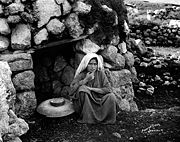
Tabun oven
Encyclopedia

Transliteration
Transliteration is a subset of the science of hermeneutics. It is a form of translation, and is the practice of converting a text from one script into another...
taboon, from the ) is a clay
Clay
Clay is a general term including many combinations of one or more clay minerals with traces of metal oxides and organic matter. Geologic clay deposits are mostly composed of phyllosilicate minerals containing variable amounts of water trapped in the mineral structure.- Formation :Clay minerals...
oven
Oven
An oven is a thermally insulated chamber used for the heating, baking or drying of a substance. It is most commonly used for cooking. Kilns, and furnaces are special-purpose ovens...
, shaped like a truncated cone
Cone (geometry)
A cone is an n-dimensional geometric shape that tapers smoothly from a base to a point called the apex or vertex. Formally, it is the solid figure formed by the locus of all straight line segments that join the apex to the base...
, with an opening at the bottom from which to stoke the fire. Built and used in pre-biblical and biblical times as the family, neighbourhood, or village oven, tabun ovens continue to be built and used in parts of the Middle East
Middle East
The Middle East is a region that encompasses Western Asia and Northern Africa. It is often used as a synonym for Near East, in opposition to Far East...
today. Nowadays some of the tabun ovens are also made out of metal
Metal
A metal , is an element, compound, or alloy that is a good conductor of both electricity and heat. Metals are usually malleable and shiny, that is they reflect most of incident light...
.
Usage
The taboon oven has historically been used to bake flatbreads such as taboon breadTaboon bread
Taboon bread ) is a flatbread wrap used in many cuisines. It is traditionally baked in a taboon oven and eaten with different fillings.Taboon bread is sold as street food, stuffed with hummus, falafel or shaved meat...
and laffa, and has been in widespread use among Arab and Jewish ethnic communities in Palestine, Israel, and the greater Middle East for centuries.
Fuel:
Many types of fuel or a combination of fuels can be used to heat a Tabun. Dried animal dung, dried bird droppings, chopped and dried tree branches or tree trimmings, wood chips,charcoal,dried tree leaves, fabrics and other available fuels.
Firing:
The top opening is covered and a layer of fuel is spread on the outside of the shell and lid. Once the fire takes hold, the fuel is covered with a layer of ash. The fuel will smolder for hours, usually all night long. The smoke also helps in repelling insects and mosquitoes. In the process the heat gets stored in the foundation. The amount of fuel varies depending on the size of oven.
Baking:
When the smoke stops, the lid is uncovered and removed and a chunks of dough are hand flattened and placed directly on the lime stones, usually 4 to 5 loaves can be baked at the same time. the opening is sealed and recovered with the hot ambers and ashes. when the bread is ready the lid is removed and the bread taken out. The process is repeated or other dishes can be baked using metal ot pottery trays. The bottom of the bread will take the shape of the pebbles. This baking process is unique and economical and the food is very aromatic and tasty.
Construction
Shell:Made of yellow pottery clay soil. The best is from Aaroub or Al Aaroub. The soil is wetted and made into a thick clay mixed with chopped wheat stem hay. The clay is hand formed to make the dome shaped shell. About 30 to 40" in diameter at its base about 15 to 20" H with an open top aprox. 15" in dia. The shell wall is about 1 to 2" thick. The shell is sun baked for weeks.
Foundation:
About 4 to 5' in diameter and about 15 to 20" in depth. Usually filled with compacted locally abundant materials known to handle and store heat. broken glass, sand, rock salt, Suwan stones (very hard compact volcanic stones).
Lid:
Made of clay or a sheet metal piece large enough to cover the top opening.
Construction:
In a sheltered area, usually a clay hut or a cave, the foundation is dug in the ground filled and compacted. The shell is placed, wider side down, on top. A layer of clean smooth lime stone pebbles about 1" in diameter is spread on top of foundation inside the shell to form a clean baking surface.

